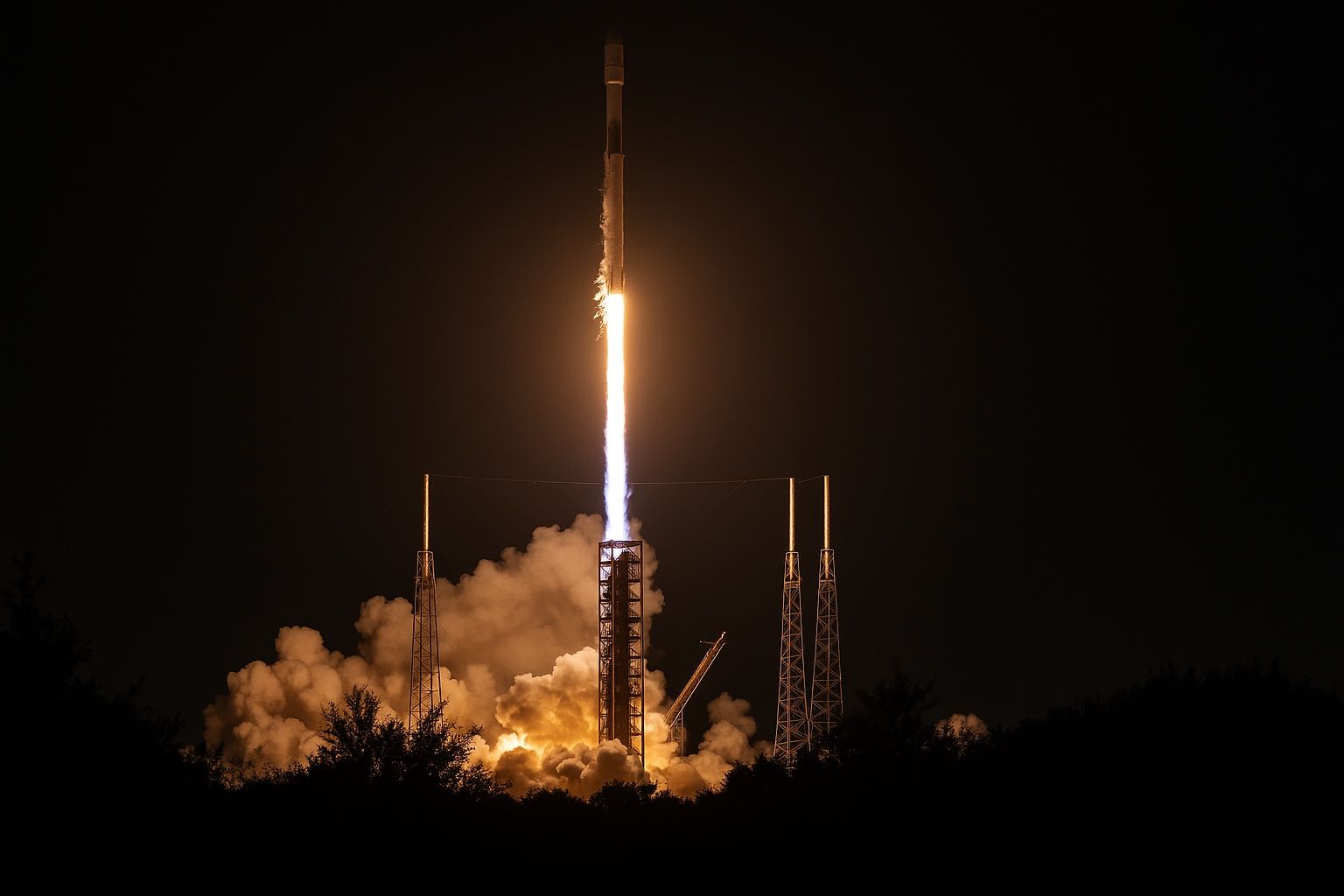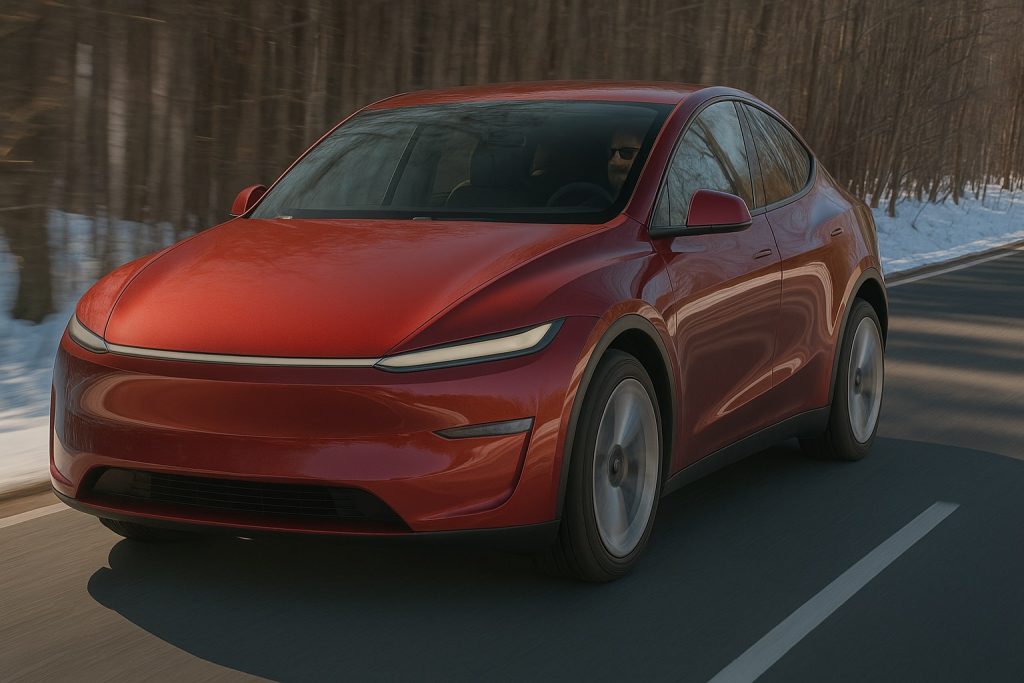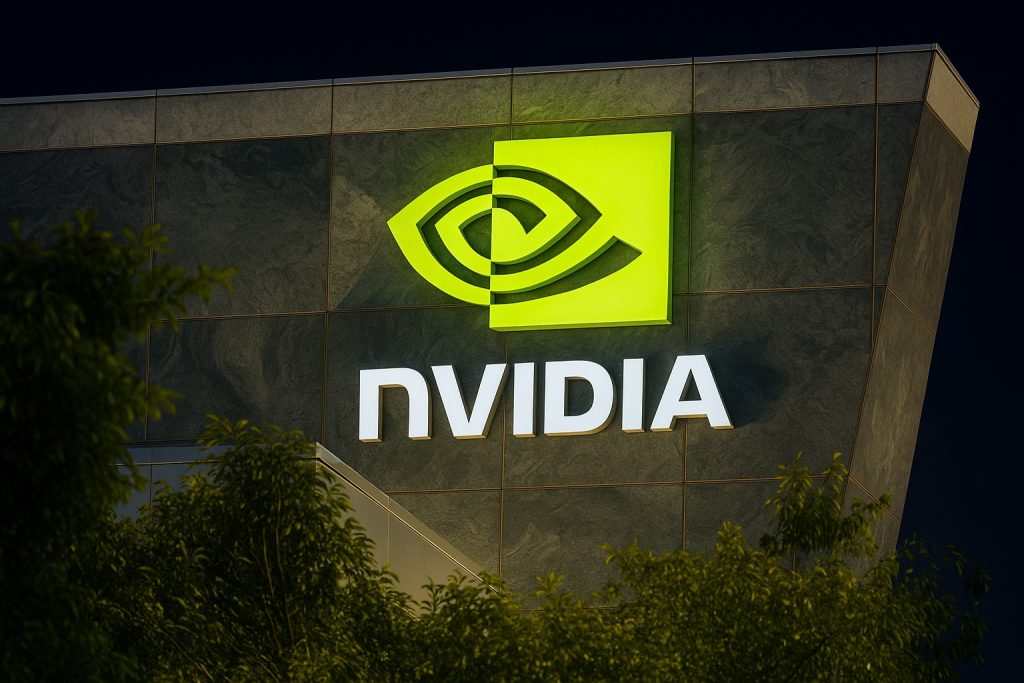Commercial Space & Satellite Industry Updates
- SpaceX’s Secret Israeli Satellite Launch: SpaceX kicked off the week with a covert Falcon 9 mission from Cape Canaveral, carrying Israel’s Dror 1 communications satellite. The launch — referred to only as “Commercial GTO-1” by SpaceX — lifted off in the pre-dawn hours of July 13 with no pre-flight publicity [1]. Israel Aerospace Industries confirmed after liftoff that Dror 1 is now in orbit, calling it “the most advanced communications satellite ever built in Israel,” designed to secure national strategic communications for at least 15 years [2]. The hush-hush approach, usually seen only with U.S. military or spy payloads, underscores Dror 1’s importance to Israel’s defense and telecom sectors.
- Starlink Launches and a New Rival Constellation: SpaceX is keeping up its rapid launch cadence with another Starlink mission. A Falcon 9 was scheduled to loft 26 Starlink v2 Mini satellites from Vandenberg on Tuesday, July 15, at 7:05 PM PDT (02:05 UTC July 16) [3]. Notably, this flight marks SpaceX’s 150th consecutive successful Falcon mission since a second-stage anomaly in 2024 broke their previous streak [4]. Hot on Starlink’s heels, Amazon’s Project Kuiper is entering the fray: SpaceX will launch Amazon’s first batch of at least 20 Kuiper broadband satellites on July 16 from Florida [5]. (ULA’s Atlas V already orbited two prototype Kuipers earlier, and Amazon has more launches booked with SpaceX, Blue Origin’s New Glenn, and Europe’s Ariane 6 [6].) These dueling megaconstellations highlight the intensifying competition in satellite internet.
- Starlink Expanding to Southeast Asia: SpaceX also notched a diplomatic win as Vietnam approved a pilot of Starlink internet service. The Science Ministry in Hanoi is expediting licensing so SpaceX can establish a local entity and begin Starlink Vietnam service in Q4 2025 [7] [8]. Officials said the trial will run through 2030, with no foreign ownership limits, as Vietnam builds out connectivity in remote areas. This move comes amid heightened demand for non-Chinese, non-Russian satellite options in Asia, and follows SpaceX quietly building ground stations in Vietnam earlier this year [9].
- $2 Billion Bet on Launch Startup – Firefly’s IPO: U.S. rocket-builder Firefly Aerospace filed for an initial public offering, signaling investor confidence returning to space ventures. In its SEC filing, Firefly revealed $60.8 million in 2024 revenue (up 10% from 2023) [10] and noted it achieved a milestone by landing its Blue Ghost spacecraft on the Moon in March [11]. The Texas-based firm (valued around $2 billion in a late-2024 funding round) aims to scale up production of its Alpha rockets, space tugs, and lunar landers [12]. Analysts say there’s a “window of opportunity” for space IPOs now, with investors upbeat about the sector’s growth prospects [13]. Firefly’s public debut would follow other 2025 space listings and provide fresh capital for its next-gen launch vehicles.
- Satellite Mega-Merger Cleared: A game-changing consolidation in the communications satellite industry is set to close. SES (of Luxembourg) confirmed it will complete its acquisition of U.S.-based Intelsat on July 17, having cleared all regulatory hurdles [14]. The multi-billion-dollar deal merges two of the world’s largest geostationary satellite operators. The combined company will operate fleets in both GEO and MEO orbits (including SES’s O3b mPOWER network) [15], serving broadband, video, and government markets. By joining forces, SES–Intelsat aims to better compete with SpaceX’s Starlink and Amazon’s Kuiper, while achieving scale efficiencies. Industry observers call it one of the biggest satellite mergers in decades, reshaping the global satcom landscape.
Government & Space Agency Highlights
- China Resupplies Space Station with Record Cargo: On July 14 (Monday), China launched its Tianzhou-9 cargo ship to the Tiangong space station, delivering a heaviest-ever load of supplies and equipment [16]. A Long March 7 rocket lofted the uncrewed freighter from Wenchang at 21:40 UTC, and Tianzhou-9 autonomously docked roughly three hours later. Aboard were 7.4 tons of goods for Tiangong’s three-person crew – food, propellant, science experiments, and even two new Feitian spacesuits [17]. The upgraded EVA suits can each sustain 20 spacewalks over four years [18], replacing older suits that exceeded their design life. This mission also disposed of the previous Tianzhou (which undocked last week and burned up on reentry) to free the port [19]. Tianzhou-9 will remain attached for ~6–7 months [20], supporting China’s ambitious pace of space station operations.
- Private Astronauts Conclude ISS Mission: Axiom Space’s Ax‑4 mission – carrying commercial astronauts from three different countries – wrapped up this week. On July 14, veteran ex-NASA astronaut Peggy Whitson (making her fifth spaceflight) and her crewmates from India, Poland, and Hungary undocked from the International Space Station aboard a SpaceX Crew Dragon [21]. The quartet had spent 18 days on the ISS conducting dozens of experiments. Their Dragon capsule splashed down off California early July 15, safely returning the crew to Earth [22]. This mission was notable for its international makeup: it included the first Polish and first Hungarian astronauts to visit the ISS, flying alongside Whitson under Axiom’s privately organized flight [23] [24]. Their successful science mission (and a live NASA TV audience via the new NASA+ streaming service) underscores the growing role of private-sector and global partners in human spaceflight.
- Crew-11 Readies for Launch: Meanwhile, NASA announced that Crew-11, the next long-duration ISS crew, is less than three weeks from liftoff. SpaceX Crew-11 is scheduled to launch July 31 from Kennedy Space Center, carrying 4 crew members: NASA astronauts Zena Cardman and Mike Fincke, JAXA astronaut Kimiya Yui of Japan, and Roscosmos cosmonaut Oleg Platonov [25]. (Yes, even amid geopolitical strains, U.S.-Russian seat swaps continue.) This mission was moved up slightly to make room for an upcoming Cargo Dragon logistics flight [26]. Notably, Crew-11 will fly on Dragon Endeavour making its sixth trip to orbit – a reuse milestone for SpaceX’s capsule fleet [27]. NASA says it might even extend Crew-11’s stint to 7–8 months (beyond the standard six), aligning with longer Russian Soyuz rotations [28]. As NASA’s Commercial Crew manager Steve Stich put it, “We’ve had to recertify Dragon” for more flights, but the vehicle is built for up to 15 missions, enabling flexibility in ISS staffing [29].
Military & National Security Space Developments
- Congress Funds Eye in the Sky Intel Program: Lawmakers are pushing the Pentagon to restore funding for a stalled TacSRT satellite intelligence initiative. The Tactical Surveillance, Reconnaissance, and Tracking program – aimed at leveraging commercial satellites for real-time imagery and tracking – was left out of the Trump administration’s FY2026 defense budget request [30] [31]. In response, the House Armed Services Committee is inserting language to permanently fund TacSRT under U.S. Space Force, ensuring military commanders worldwide have access to rapid commercial Earth-imaging and analytics [32]. Advocates say integrating private-sector geo-intel (from firms like Maxar, Planet, etc.) will vastly improve battlefield awareness. By mandating this funding, Congress signals bipartisan agreement that space-based ISR is a top priority, even if the White House tried to zero it out.
- Pentagon Bill Mandates Heavy-Lift and Safer Launches: The Senate’s draft NDAA (defense authorization bill) includes several space-related directives [33]. One provision instructs the Air Force to assess U.S. heavy-lift launch capacity – reflecting concern that national security missions might need more alternatives as ULA’s Delta IV retires and new heavy rockets (New Glenn, Vulcan) come online. Another section calls for safety protocols on methane-fueled rockets [34] (like SpaceX’s Starship or Blue Origin’s engines), likely prompted by recent test mishaps. The bill also emphasizes improving missile defense in space and protecting satellite spectrum from interference [35] [36]. Senators voted 26–1 to advance this defense bill out of committee [37]. If enacted, its mandates will nudge the Pentagon to invest in next-gen launch systems and enforce higher safety standards – ensuring the military’s space operations remain robust and secure.
Space Science & Exploration Breakthroughs
- Sun at Point-Blank Range – Parker Probe’s New Milestone: NASA’s Parker Solar Probe has captured the closest-ever images of the Sun, coming within just 3.8 million miles of the solar surface [38]. The probe’s WISPR camera snapped high-resolution views of the Sun’s outer corona and solar wind – the stream of charged particles blasting out at over a million miles per hour [39]. These images, taken during Parker’s record-breaking perihelion late last year, are a treasure trove for heliophysicists. “Parker Solar Probe has once again transported us into the dynamic atmosphere of our closest star,” said Dr. Nicky Fox, head of NASA’s science missions [40]. “We are witnessing where space weather threats to Earth begin… This new data will help us vastly improve our space weather predictions to ensure the safety of our astronauts and the protection of our technology here on Earth,” Fox noted [41]. By directly sampling the Sun’s environment, Parker is answering fundamental questions about how the solar wind forms – knowledge that will improve forecasting of geomagnetic storms that can disrupt satellites and power grids.
- Hubble Reveals “Time Capsule” Star Cluster: The Hubble Space Telescope has peered into a glittering globular cluster in our neighboring galaxy, yielding clues about multi-generational star formation. In a new image release, Hubble resolved thousands of stars in NGC 1786, a dense star cluster in the Large Magellanic Cloud (~160,000 light years away) [42]. Astronomers found that NGC 1786 contains stars of many different ages, overturning the old assumption that all stars in a globular cluster are born at the same time [43]. This “cosmic time capsule” suggests globular clusters can undergo multiple bursts of star formation over eons [44]. By comparing such clusters in the LMC to those around the Milky Way, scientists hope to retrace how small galaxies and big galaxies assembled in the early universe [45] [46]. The discovery of layered stellar populations is helping refine theories of galaxy evolution, showing that even ancient star clusters can harbor complex histories.
- Other Notable Science Updates: In planetary news, NASA’s Perseverance rover marked its 500th Martian sol this week (busy collecting samples for a future return), while ESA’s Euclid space telescope (launched in 2023) released preliminary maps of dark matter in the cosmos – teasing the breakthrough results to come. And on the space medicine front, startup Varda Space Industries announced it raised $187 million to accelerate its drug-manufacturing-in-orbit technology [47]. Varda’s latest capsule, launched via SpaceX in June, is currently hosting pharmaceutical experiments in microgravity, with return to Earth planned soon [48] [49]. These developments highlight how space science is advancing on all fronts: from understanding our Sun and galaxies far away, to leveraging low Earth orbit for innovation in biotech.
Space Policy & International Developments
- US Congress Boosts NASA – Rejects Deep Cuts: Capitol Hill delivered some relief for NASA in budget deliberations. The House Appropriations Committee unveiled a draft FY2026 spending bill that keeps NASA funding flat at $24.8 billion, explicitly rejecting the White House’s proposed 24% cut that alarmed scientists [50]. (President Trump’s budget had sought to slash NASA to $18.8 billion, including nearly halving science programs [51] [52].) Instead, House lawmakers reallocated money toward Artemis exploration: the bill boosts NASA’s deep-space exploration account to $9.7 billion (about $2 billion above current levels) while trimming some earth science and aeronautics funding [53] [54]. Critically, Congress flatly rejected the administration’s plan to terminate the SLS rocket and Orion capsule after Artemis III [55]. “This bill ensures America remains the global leader in space exploration as adversaries like China ramp up aggression,” said Rep. Hal Rogers, who oversees NASA’s budget [56]. Indeed, both House and Senate appropriators signaled they want Americans back on the Moon by 2027 (Artemis III) before China’s planned 2030 lunar landing [57]. In a bonus, Congress even funded the dormant National Space Council at $1.9 million, anticipating the administration will re-establish the high-level space policy group [58] [59]. NASA supporters are hailing these moves as averting a potential “dark age” for U.S. space science [60] [61] – though the final budget must still survive fall negotiations.
- Climate Reports Caught in Political Crossfire: In a controversial reversal, the Trump administration halted plans for NASA to host major climate change reports on its website [62]. Earlier this month, the White House had taken down the federal climate assessment website (globalchange.gov) and said NASA would republish those legally mandated reports. However, on July 14 NASA announced it “aborted those plans,” noting it has “no legal obligation” to host the data [63]. The decision means the authoritative National Climate Assessment and related data will not be easily accessible via NASA, sparking criticism from scientists. Former White House science adviser John Holdren accused the administration of “classic misdirection” – offering to let NASA post the reports, then quietly pulling the plug two weeks later [64] [65]. He and other experts say this is an attempt to bury the scientific findings of climate damage across the U.S. (which disproportionately threatens vulnerable communities) [66] [67]. For its part, NASA’s press secretary stated that the reports were delivered to Congress as required, and past editions remain archived on a NOAA library site [68] [69]. This tug-of-war highlights how even NASA – traditionally above politics – is being thrust into contentious climate policy debates.
- Europe Gets Serious on Space Regulation: Across the Atlantic, the European Union is overhauling how it governs the space sector. A proposed “EU Space Act” was unveiled that would give Brussels unprecedented regulatory and enforcement powers over both domestic and foreign satellite operators [70]. The draft framework, championed by EU Commissioner Thierry Breton, aims to unify oversight of everything from launch safety standards and orbital debris mitigation to cybersecurity requirements for satellites. Notably, the EU Space Act would enable on-site inspections of space companies and impose steep fines for non-compliance on sustainability and safety rules [71]. This is a marked shift – historically Europe’s space regulations were fragmented by country. The move comes as Europe ramps up its investment in next-gen constellations (like the planned IRIS² sovereign satcom network) and seeks to protect its assets in an increasingly crowded orbit. Industry stakeholders are watching closely: while the Act promises a “level playing field” and tougher enforcement (including on non-European operators over Europe), companies worry about potential over-regulation. Still, the initiative signals that the EU wants to speak with one voice on space policy and bolster its role as a global space power [72].
- International Partnerships and Diplomacy: Cooperation in space continues to deepen on multiple fronts. In Washington, President Trump hosted India’s Prime Minister earlier this summer, where NASA and ISRO cemented plans for a joint NASA-ISRO Synthetic Aperture Radar (NISAR) mission and agreed to exchange astronaut training opportunities – underlining the growing US–India space partnership. The Artemis Accords also gained new signatories (Norway became the 55th nation to join in May), reflecting broadening support for peaceful exploration norms. And the Axiom-4 mission itself was a diplomatic milestone: the flight was enabled by a U.S.-Poland-Hungary agreement, making it a showcase of how countries can collaborate through commercial space. Even as geopolitical tensions persist (Russia and China are pursuing their own lunar base MOU apart from Artemis), the day-to-day reality on the ISS and in programs like Artemis is one of remarkable international teamwork. As former NASA Administrator Bill Nelson often quipped, “In space, we achieve more when we work together” – a mantra being tested and proven again in 2025.
Sources: Spaceflight Now [73] [74] [75] [76] [77]; Reuters [78] [79] [80]; SpaceNews [81] [82] [83]; NASASpaceflight [84] [85]; Reuters/AP [86] [87]; NASA/ESA releases [88] [89].
References
1. spaceflightnow.com, 2. spaceflightnow.com, 3. www.nasaspaceflight.com, 4. www.nasaspaceflight.com, 5. www.nasaspaceflight.com, 6. www.nasaspaceflight.com, 7. www.reuters.com, 8. www.reuters.com, 9. www.reuters.com, 10. www.reuters.com, 11. www.reuters.com, 12. www.reuters.com, 13. www.reuters.com, 14. spacenews.com, 15. spacenews.com, 16. www.nasaspaceflight.com, 17. www.nasaspaceflight.com, 18. www.nasaspaceflight.com, 19. www.nasaspaceflight.com, 20. www.nasaspaceflight.com, 21. www.reuters.com, 22. www.reuters.com, 23. www.reuters.com, 24. www.reuters.com, 25. spaceflightnow.com, 26. spaceflightnow.com, 27. spaceflightnow.com, 28. spaceflightnow.com, 29. spaceflightnow.com, 30. spacenews.com, 31. spacenews.com, 32. spacenews.com, 33. spacenews.com, 34. spacenews.com, 35. keeptrack.space, 36. keeptrack.space, 37. spacenews.com, 38. science.nasa.gov, 39. science.nasa.gov, 40. science.nasa.gov, 41. science.nasa.gov, 42. sciencedaily.com, 43. sciencedaily.com, 44. sciencedaily.com, 45. sciencedaily.com, 46. sciencedaily.com, 47. www.reuters.com, 48. www.reuters.com, 49. www.reuters.com, 50. spacepolicyonline.com, 51. spacepolicyonline.com, 52. spacepolicyonline.com, 53. spacepolicyonline.com, 54. spacepolicyonline.com, 55. spacepolicyonline.com, 56. spacepolicyonline.com, 57. spacepolicyonline.com, 58. spacepolicyonline.com, 59. spacepolicyonline.com, 60. spacepolicyonline.com, 61. spacepolicyonline.com, 62. apnews.com, 63. apnews.com, 64. apnews.com, 65. apnews.com, 66. apnews.com, 67. apnews.com, 68. apnews.com, 69. apnews.com, 70. spacenews.com, 71. spacenews.com, 72. spacenews.com, 73. spaceflightnow.com, 74. spaceflightnow.com, 75. www.nasaspaceflight.com, 76. www.nasaspaceflight.com, 77. www.nasaspaceflight.com, 78. www.reuters.com, 79. www.reuters.com, 80. www.reuters.com, 81. spacenews.com, 82. spacepolicyonline.com, 83. spacepolicyonline.com, 84. www.nasaspaceflight.com, 85. www.nasaspaceflight.com, 86. www.reuters.com, 87. apnews.com, 88. science.nasa.gov, 89. sciencedaily.com










